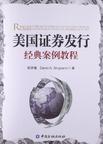美国证券发行经典案例教程
2012-11
姚承曦、 David A.Sirignano 中国金融出版社 (2012-11出版)
姚承曦,David A.Sirignano 著
582
无
由中国汕头大学商学院姚承曦教授和美国前联邦证券与交易委员会官员David Sirignano合著的Regulation of Securities Of ferings and Investment Banking:Casesand Materials for Study in U.S. Securities Act of 1933《美国证券发行经典案例教程》,从金融与监管的角度,系统并突出中国企业特色,介绍了美国证券发行市场的运行机制和监管理论。诚然,美国资本市场的监管体系不一定全面满足我国资本市场的需要。然而,知己知彼,百战不殆。作为全球第二大经济体的中国,要使更多的大型企业在国际经济领域纵横捭阖,促进更多的中小型企业成长壮大,实现国民经济持续高速增长,高效、健康和多层次的中国资本市场起的作用将举足轻重。研究和掌握美国资本市场的历史发展、运作与管理,乃为期望在国内外资本市场有所作为的我国学生所必修之课。
作者:姚承曦 (美国)David A.Sirignano 姚承曦现任中国广东汕头大学商学院金融与证券监管学教授。姚承曦在美国证券业工作近二十年,包括证券监管部门和证券业界工作经历。历任美国全国证券交易商协会(NASD)法律顾问处律师,纳斯达克股票市场(NASDAQ)国际市场法律顾问,纽约股票交易所(NYSE)券商监管部高级法律顾问,和纽交所国际部亚太地区(包括中国上市公司)和加拿大国家上市公司经理。在业界,姚承曦先后任大型综合型券商公司监察副总裁和资本市场法律顾问;其后在全球最大共同基金集团Fidelity Investments任国际资本市场监管副总裁。姚承曦的监管范围包括:证券零售市场、资本市场、投资管理、美国国内市场和国际市场。姚承曦获美国波士顿学院法学院法学博士学位(Juris Doctor),乔治敦大学法学研究中心金融与证券监管学硕士学位(LLM in Securitiesand Financial Regulation)。期间获乔治敦优秀研究生奖,及全美法学院国际金融研究奖。此前,姚承曦在中华人民共和国获联合国译员训练班研究生文凭,英美文学硕士学位,及英文本科文凭。姚承曦的英文专著, “Stock Market andFutures Market in the People's Republic ofChina,”由牛津大学出版社在美国、英国及中国香港发行。 David A. Sirignano,David A. Sirignano is a partner in the Washington, D.C. office of Morgan Lewis & Bockius LLP, and Co-Head of the firm's Securities Practice. Mr. Sirignano focuses on intemational and domestic corporate finance, mergers and acquisitions, and SEC regulation. He currently is a Vice-Chair of the Federal Regulation of Securities Committee of the American Bar Association, and previously was the Chair of the Corporate Reporting and Disclosure Subcommittee of the ABA Committee. He was Co-Chair of the ABA Task Force on Cross Border Offerings and Acquisitions. He has also served on the Corporate Finance Advisory Committee of FINRA.Before joining the firm in 1999, he was Associate Director for International Corporate Finance in the United States Securities and Exchange Commission's Division of Corporation Finance. In that position, he developed SEC policy on cross-border offerings, acquisitions, and listings, including offshore Intemet offenngs,international disclosure and accounting standards,as well as international corporate governance guidelines. He also advised the SEC Division of Enforcement on financial fraud cases and cross-border offering abuses. Mr. Sirignano was an adjunct professor at Georgetown University Law Center, where he taught the Course on Mergers and Acquisitions.
In Perspective: Securities and Financial Regulation Foreword-美国法学者序 Foreword-中国经济学者序 SUMMARY OF CONTENTS TABLE OF CONTENTS CHAPTER 1 SECURITIES OFFERINGS: REGISTRATION REQUIREMENT AND EXEMPTIONS Section 1.1 Public Offerings: The Disclosure System 1.1.1 Overview of Registration Process 1.1.2 ECMH, Integrated Disclosure System and Disparate Quality Dilemma 1.1.3 ECMH, Shelf Offering and Due Diligence Dilemma Section 1.2 Non-Public Offerings: Transactions Exempt from Registration. 1.2.1 Section 4(a)(2) Exemption for "Transactions by an Issuer Not Involving Any Public Offering". 1.2.2 Regulation D Safe Harbor for Offering by Issuer to Accredited and Sophisticated Investors: Integration Doctrine 1.2.3 Rule 144A Safe Harbor for Offering by Non-Issuer Seller to Qualified Institutional Buyers QIBs 1.2.4 Section 3(a)(11) Intrastate Offering Exemption for Local Financing Section 1.3 Going Public the Non-Traditional Way and Theory of Sale 1.3.1 Spin Off. 1.3.2 Reverse Merger and Back Door Registration CHAPTER 2 MATERIALITY AND CIVIL LIABILITY Section 2.1 Concept of Materiality 2.1.1 Meaning of Material Fact 2.1.2 MD&A: Management's Discussion and Analysis of Financial Statements 2.1.3 Forward-Looking Statements: Bespeaks Caution Doctrine and Its Progeny Section 2.2 Standards of Civil Liability 2.2.1 Public Offering: Liability for False Registration Statement 2.2.2 All Offerings: Liability for Fraudulent Offer or Sale of Securities 2.2.3 Securities Professional as Statutory Seller CHAPTER 3 UNDERWRITING AND STATUTORY UNDERWRITER Section 3.1 Syndicate Book-Building and Aflermarket Activities 3.1.1 Integrity of Public Offering Process: Pricing and Allocation 3.1.2 Syndicate Stabilizing, Aftermarket Covering, and Penalty Bids Section 3.2 Investment Banking-Research Conflicts of Interest 3.2.1 Managing Investment Banking-Research Conflicts of Interest 3.2.2 Research Publication in connection with an Offering Section 3.3 Statutory Underwriter 3.3.1 Primary Distribution by Issuer 3.3.2 Secondary Distribution by Controlling Shareholder CHAPTER 4 PROSPECTUS; FREE WRITING PROSPECTUS ILLEGAL OFFER Section 4.1 Pre-Filing Period: Concept of Conditioning the Market 4.1.1 Section 5(c) Prohibition against Gun Jumping 4.1.2 "Conditioning the Market" Concept Modemized Section 4.2 Waiting Period: Concept of Non-Conforming Prospectus 4.2.1 Section 5(b)(1) Prohibition against Free Writing 4.2.2 "Free Writing Prospectus" as Modem Concept Section 4.3 Post-Effectiveness and Aflermarket: Final Prospectus 4.3.1 Sections 5(b)(2)/4(a)(3) Requirements of Final Prospectus Delivery 4.3.2 Timing Asymmetry: Investment Decision and Information Availability CHAPTER 5 INNOVATIVE FINANCIAL PRODUCTS AND INTERNET OFFERINGS Section 5.1 What Is a "Security" 5.1.1 Investment Contracts: Variable Schemes vs Economic Reality 5.1.2 Hybrid Insurance-Securities Products 5.1.3 OTC Derivatives: Equity Swap and Synthetic Option 5.1.4 OTC Derivatives: Credit Default Swap (CDS) Section 5.2 Securities Offerings over Internet 5.2.1 Public Offering: Altematives to Traditional Firm Commitment Underwriting 5.2.2 Capital Raising from the Online Crowd: Crowdfunding Small and Micro Businesses 5.2.3 Free Stock Distribution on Internet: Theory of Sale Applied to CyberShares
版权页: 插图: HealthSouth Corporation, an NYSE-listed company, was unable to undertake any customary public offerings due to its dire financial problems and being concerned over SEC's scrutiny over registration statements. It raised $2.4 billion through a "Rule 144A/Exxon Capital Exchange" debt issuance, a capital raising technique named after Exxon Capital Holdings Corporation which in 1988 sought and obtained an SEC no-action letter for use of the structure. A Rule 144A/Exxon Capital Exchange structure involves two steps to achieve a lower cost of capital: aprivate offering to QIBs exempt under SEC Rule 144A, followed by a registered exchange offering to allow the Rule 144A unregistered bonds,which are subject to resale restrictions, to be exchanged for identical registered bonds, which are freely tradable in the public market. Section 11(a) of the Securities Act allows any purchaser of a security to sue the statutorily-specified parties such as the issuer, accountants, underwriters, and signers of the registration statement in respect of the security "in case any part of the registration statement, when such part became effective, contained an untrue statement of a material fact or omitted to state a material fact required to be stated therein or necessary to make the statements therein not misleading."Since a QIB's decision to own a registered bond obtained in a 144A/Exxon Capital Exchange occurred before the filing of the registration statement,specifically, when the QIB decided to purchase the unregistered bond, registered bonds acquired through a 144A/Exxon Capital Exchange are not traceable to the registration statement and thus are not protected by Section 11 (a). Ten factors provide an analytical framework for evaluating the efficiency of a bond market, vis-a-vis the efficiency of a stock market, to determine applicability of the Fraud-on-the-Market Theory to the bond market.
《美国证券发行经典案例教程》作者长期在美国从事证券交易工作,具有很丰富的市场经验。《美国证券发行经典案例教程》对美国证券发行的经典案例进行了梳理,并对案例进行了点评,有助于实务工作者、研究人员学习和了解美国证券发行法律。

无
这两套书都有比较不错的案例,而且包装内容都不错